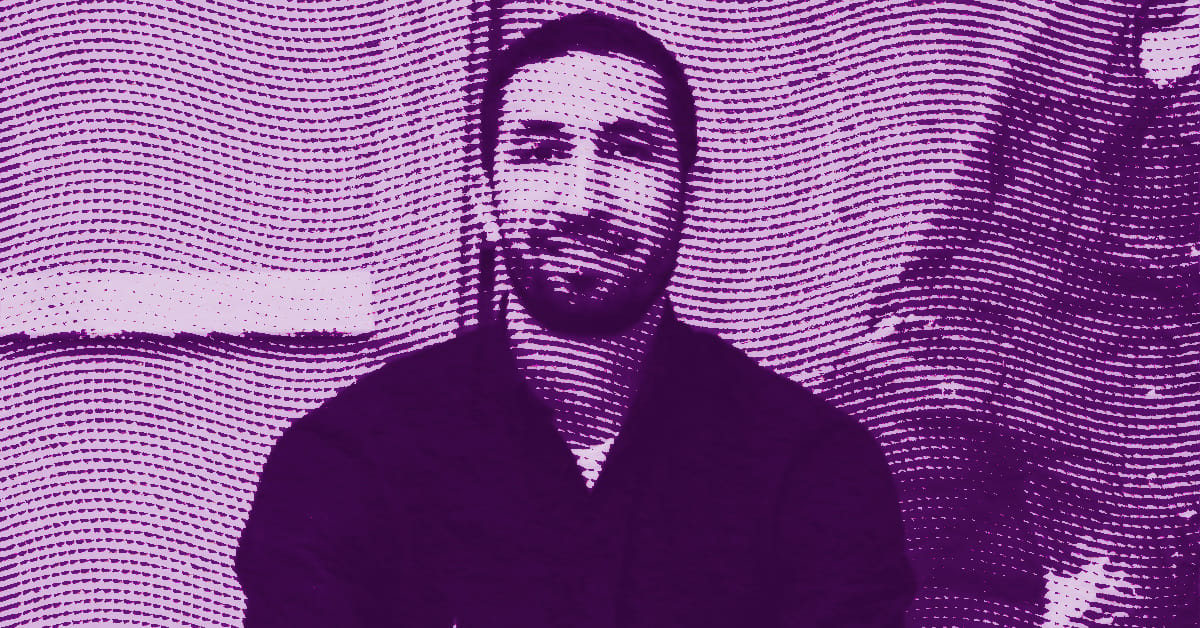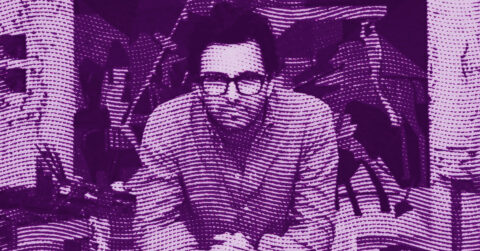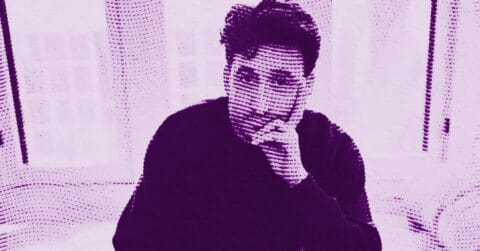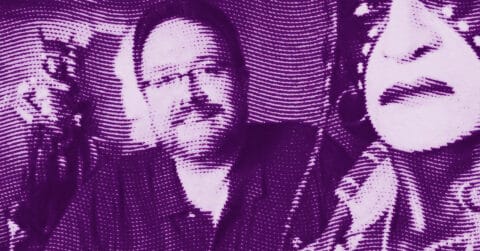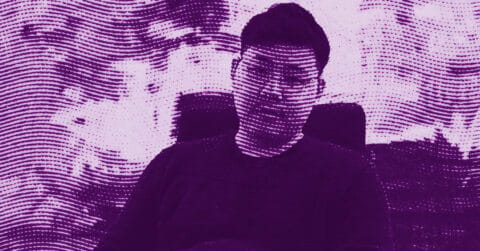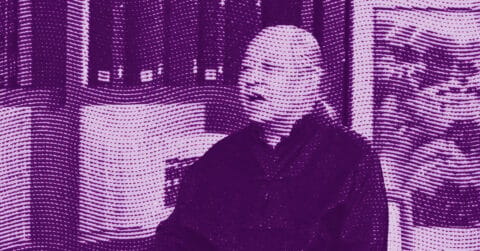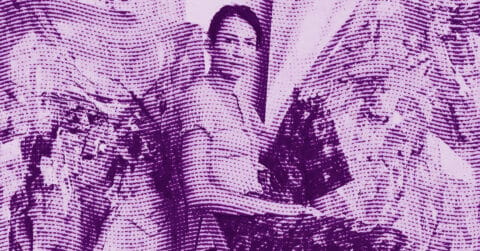Listen to me carefully, you bunch of snobs: while you marvel at the latest conceptual installations where three potatoes converse with a blinking neon light, a man paints. He really paints, with oil, canvas, time, and silence. Bilal Hamdad, born in Sidi Bel Abbès in 1987, neither asks for your blessing nor your indulgence. He simply captures that Paris you pass through without seeing it, those faces you encounter without looking at them, those moments you erase as soon as they happen. His brush is not a reproduction tool but a scalpel that dissects the invisible present of our metropolises.
Hamdad’s painting is unsettling because it refuses the easy comforts of clichéd discourse. One would like to confine him in the convenient cage of “hyperrealism,” that catch-all category that exempts one from thinking. He is far more than that. Truly look at his canvases: bodies dissolve into shadow, faces become specters behind the windows, the pictorial material pulses and vibrates far from any servile imitation. Hamdad does not copy reality; he recomposes it from dozens of photographs to extract a truth that the hurried eye could not perceive. His large compositions, two meters or more, compel us to slow down, to remain still, to accept the discomfort of contemplation.
Urban hermeneutics
Hamdad’s approach finds a unique echo in the thought of the German sociologist Siegfried Kracauer, a major intellectual figure of the Weimar Republic. Kracauer developed what he called a surface hermeneutics, an analytical method that considers that “the place a period occupies in the historical process is more pertinently determined from the analysis of its discrete surface manifestations than from the judgments it has about itself” [1]. This approach, radically opposed to large abstract theoretical syntheses, favors the meticulous observation of seemingly insignificant details of urban life. Cinema, architecture, subway movements, bodily attitudes: everything becomes material for sociological understanding.
Hamdad proceeds exactly thus. His paintings do not seek to illustrate pre-established concepts of solitude or contemporary alienation. The artist himself specifies: he never defines a subject before starting a canvas; he begins from a desire to paint rather than from a discourse. His canvases constitute a visual archive of surface manifestations of our era: the sanitary mask, the mobile phone, the wifi pictogram, the streetcorn vendor in front of Barbès-Rochechouart. These elements are not artificially added symbols but authentic traces of a precise historical moment. Just as Kracauer scrutinized Berlin hotel lobbies or vaudeville shows to discern the deep structures of capitalist modernity, Hamdad examines subway platforms and escalator exits to reveal the contemporary configurations of urban existence.
The Arts et Métiers station in Le Mirage, with its copper walls evoking the Nautilus, thus becomes more than just a simple set. It embodies those non-places theorized by anthropologist Marc Augé, interchangeable spaces of supermodernity where the individual remains anonymous. But Hamdad goes further: through the play of reflections on metallic surfaces, he multiplies viewing angles, revealing what direct observation conceals. The passerby is shown in profile, masked, absorbed by her screen. This multiplication of the visible by the visible itself constitutes a mise en abyme of Kracauer’s sociological method. Reflective surfaces do not lie; they expose what the accustomed gaze no longer bothers to note.
Hamdad’s method shares with Kracauer’s an obsessive attention to the rhythms and gestures of metropolitan daily life. In Escale II or L’Attente, the characters are captured in those moments of temporal suspension characteristic of the urban experience: one waits, transits, exists in the in-between. These hollow moments, which classical philosophy would deem unworthy of attention, become, for Hamdad, social revelators of primary importance. They expose the individual’s relationship to public space, strategies of withdrawal or presence, micro-behaviors that structure collective life without ever being the subject of explicit consciousness.
Rive droite, this vast fresco at the Barbès-Rochechouart metro exit, pushes this logic to its peak. Hamdad deploys here a true sociological sampling of the contemporary metropolis: the African vendor, hurried passersby, agents in yellow vests, the couple holding hands. Every detail matters, every presence speaks. The commemorative plaque evoking the Colonel Fabien attack against the Nazi occupier remains defaced by graffiti, as if collective memory had abdicated before the urgency of the present. This juxtaposition of the memorial and the current, the historical and the banal, precisely constitutes what Kracauer called the analysis of “discreet surface manifestations.” The era reveals itself in what it neglects as much as in what it celebrates.
The poetics of the fugitive
Hamdad’s work also summons, through an internal necessity rather than cultural affectation, the poetic universe of Charles Baudelaire. The poet of the Fleurs du mal was the first to theorize modernity as an experience of the transient, the fleeting, the contingent. His sonnet “À une passante”, often cited regarding Hamdad, condenses this aesthetic of the instant: “A flash… then night! Fugitive beauty / Whose gaze suddenly made me reborn / Will I see you no more than in eternity?” [2]. This aborted encounter, this presence that arises and fades, structures both Baudelaire’s poetry and Hamdad’s painting.
Le Mirage is the most striking example. The woman seen from behind in the metro, revealed by her reflections, perfectly embodies this Baudelairian “fugitive beauty.” She exists for the viewer only in this suspended instant, this temporal short-circuit where the visible doubles and simultaneously eludes. She will never be seen again, yet she remains fixed on the canvas, eternalized in her very flight. This Baudelairian dialectic of the fleeting and the eternal runs through all of Hamdad’s work. His characters are always in transit, never truly present, already elsewhere in their head or on their screen. They inhabit that specifically modern time that Baudelaire was the first to name: a present without thickness, torn between recollection and anticipation.
The Baudelairean notion of the “painter of modern life” also illuminates Hamdad’s approach. Baudelaire celebrated Constantin Guys for his ability to capture “the ephemeral, the fleeting, the contingent, half of art, the other half being the eternal and the immutable.” Hamdad proceeds exactly in this manner in his large urban compositions. He captures the ephemeral, that passerby, that light, that gesture, but fills it with a pictorial density that shifts it into another temporality, that of the work of art. The Quechua tents of the homeless, the blue vests of the Samu Social, the police uniforms: so many contingent details that, under Hamdad’s brush, acquire an almost archaeological gravity. These objects bear witness, they constitute the still warm fossils of an era that looks at itself without understanding itself.
Baudelaire’s melancholy also permeates Hamdad’s canvases, this “glorious melancholy” that the poet associated with modernity. Patrick Modiano, whose quote opens the Solitudes croisées exhibition catalogue, continues this Baudelairean affect in contemporary Paris: “There existed in Paris intermediate zones, no man’s lands where one was at the edge of everything, in transit, or even suspended” [3]. These zones, Hamdad paints tirelessly. They are his territories of choice: parking lots, metro corridors, deserted sidewalks of Saint-Rémy-de-Provence. Transitional spaces that become, under his gaze, places of a strange urban poetry, both familiar and unsettling.
The solitary crowd, a central theme of Baudelairean modernity, finds a striking pictorial translation in Hamdad’s work. In Rive droite, each character is alone in the crowd, enclosed in his perceptual bubble. They coexist without seeing each other, brush past without truly touching. This proximity without contact, this co-presence without relation, defines metropolitan experience since Baudelaire. Hamdad adds no unnecessary pathos, no moral commentary. He shows simply, and this showing is enough to reveal the affective architecture of our time. The lowered faces, averted glances, absorption in screens: so many withdrawal strategies that transform public space into an archipelago of juxtaposed solitudes.
Painting as a political act
It would be convenient but false to reduce Hamdad’s work to a disillusioned observation of contemporary alienation. His painting carries a political charge that does not say its name, that refuses blatant activism in favor of the discreet effectiveness of showing. When Hamdad paints migrants’ tents in disused architectures, when he depicts the homeless curled up in their sleeping bags, when he captures precarious workers and street vendors, he accomplishes a major political gesture: he makes visible what society prefers not to see. As Virginie Despentes writes in a quote reported by the catalogue, we are “vaccinated like many city dwellers, accustomed to the misery of others, but always a bit ashamed to look away.” Hamdad’s painting prevents us from looking away.
This political dimension is rooted in a claimed lineage with Gustave Courbet. Rive droite explicitly takes up the structure of L’Atelier du peintre, transposing the realistic allegory of the 19th century into the cosmopolitan Paris of the 21st. Just as Courbet showed “society in its upper, its lower, its middle”, Hamdad unfolds a social cartography of the contemporary metropolis. Courbet’s nude becomes a billboard, the pastoral landscape becomes a metro map, but the principle remains: painting as a symbolic gathering place of all social strata. Hamdad thus updates Courbet’s realistic project, showing that great painting can still speak about the world without resorting to the ease of abstraction or conceptual tricks.
Hamdad’s formal choices also partake in this political stance. His large formats, deliberately using the dimensions of history painting, assert the importance of his subjects. A homeless person, a metro exit, a corn vendor deserve these two meters of canvas that academicism reserved for heroes and gods. This scaling gesture is in itself an act of resistance against the hierarchy of subjects that secretly endures in the art world. Hamdad proclaims through his formats that these anonymous existences possess a pictorial dignity equivalent to that of the powerful. There is something deeply democratic here, in the noblest sense of the term.
Painting as an exercise of the gaze
Bilal Hamdad’s work today establishes itself as one of the most necessary on the French art scene. Not by technical virtuosity, though that is undeniable, nor by formal originality, though that exists. It asserts itself because it accomplishes what only painting can: it teaches us to look at what we see. Between Kracauer and Baudelaire, between sociology of the surface and poetics of the fleeting, Hamdad builds a visual archaeology of the present. His canvases function as temporal slowdowns, salutary obstacles opposed to the blinding speed.
His museum exhibition entitled “Paname”, organized with the support of the Templon gallery, currently on view at the Petit Palais and until February 8, 2026, marks a well-deserved institutional recognition. In front of Courbets and Lhermittes, his canvases hold their own. They engage on equal terms with the masters, proving that great figurative painting is not dead, not even ill. It simply demands painters capable of carrying it, artists who accept the slowness of the medium, the rigor of looking, the rejection of conceptual shortcuts. Hamdad is one of them. He paints because he cannot not paint, because painting remains the most precise tool to capture the infinite nuances of the visible.
Beyond convenient labels, hyperrealism, social realism, urban painting, Hamdad’s work poses a simple but dizzying question: what do we see when we look? His canvases suggest that we see almost nothing, that our gaze slips over surfaces without ever really stopping there. The painter, he looks. He looks with obstinacy, with method, with love as well. He looks at this city we inhabit without truly being there, these faces we cross without meeting, these moments we live without really living them. And by showing us the result of this patient gaze, he offers us the possibility to finally see, perhaps, a little of what constitutes our contemporary condition.
Time will tell if Hamdad joins the pantheon of great painters of urban modernity, alongside a Hopper or a Hammershøi. For now, he paints. He paints this Paris of 2025, this saturated and solitary metropolis, violent and fragile, cosmopolitan and segregated. He paints without nostalgia for a mythified past, without cynicism toward the present, without illusion about the future. He paints because painting, today, constitutes in itself an act of resistance against the empire of disposable images and hollow discourses. In a world that values speed and forgetting, Hamdad chooses slowness and memory. His brush engraves in the pictorial material fragments of existence which, without him, would have dissolved into the undifferentiated flow of time. This is perhaps the essential gesture of art: to snatch from oblivion some shards of truth, and offer them to those who still accept to truly look.
- Siegfried Kracauer, cited in the catalog of the exhibition Solitudes croisées, 2022, text by Hélianthe Bourdeaux-Maurin
- Charles Baudelaire, “To a Passerby”, Les Fleurs du mal, 1857
- Patrick Modiano, In the Café of Lost Youth, cited in the catalog of the exhibition Solitudes croisées, 2022

